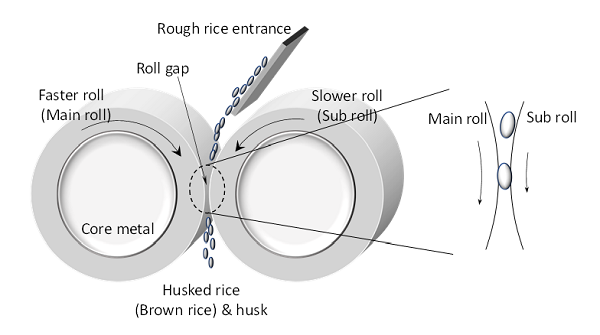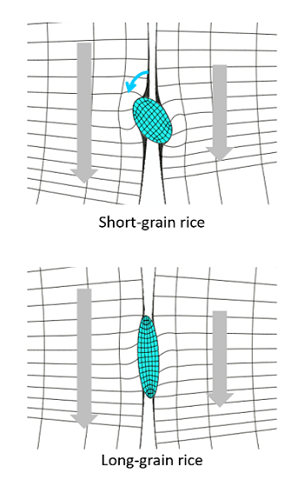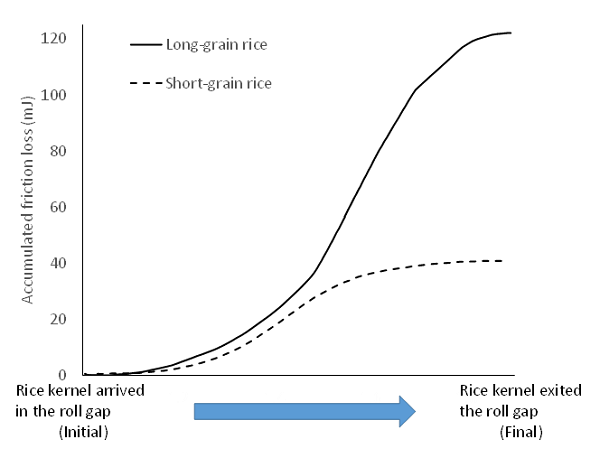Designing a polyurethane-based husker roll for long-grain rice using a finite element model
Description
Rice husking is an operation where the husks are peeled from rough rice, and a rubber roll husker conventionally consists of two rubber rolls with different peripheral velocities that rotate to provide the shear stress needed to husk rough rice (Fig. 1). Both short- and long-grain rice, which have different shapes, affect rice husker performance, especially the husking ratio and wear of the husker roll. The performance with long-grain rice, which accounts for 80% of world rice production, is poorer than with short-grain rice.We analyzed the fundamental mechanisms of the roll husker, and then compared the performance for long- and short-grain rice using a finite element model constructed based on high-speed camera observation.
A husking simulation based on the constructed model revealed that long-grain rice exhibited more accumulated friction loss (121.6 mJ) than short-grain rice (40.1 mJ) (Figs. 2 & 3). The difference in accumulated friction loss at the roll surface may lead to increased friction heat, which in turn induces wear. Since sufficient shear force is needed with rough rice to achieve a higher husking ratio, the optimum coefficient of friction and Young’s modulus of the husker roll, which is related to viscoelasticity, for long-grain rice were calculated based on the model as being 0.8 and 8.1 MPa, respectively.
Newly designed polyurethane-elastomer-based husker rolls based on these results showed a better husking ratio and nearly 10 times greater durability than conventional rubber rolls in experiments undertaken in Thailand using long-grain rice (Table 1).
Roll huskers are the mainstream in commercial rice mills around the world, in terms of continuous operation and brown rice quality after husking. Their replacement rolls are commercially available as consumables, and the developed polyurethane-based husker roll is applicable to all roll huskers. Therefore, the results provide new opportunities to prepare new materials for the rice roll husker.
Figure, table
-
Fig. 1. Schematic diagram of rice roll husker
-
Fig. 2. Differences between short- and long-grain rice in the roll gap
-
Fig. 3. Accumulated friction losses for husking of single kernel
-
Table 1. Results from field husking tests at a rice mill in Thailand
Husker roll Viscoelasticity
(tanδ, 90°C)Coefficient of friction Husking
ratioBroken rice ratio Actual
wearingEstimated durability Rubber roll (conventional) 0.089 0.514 77-85% 7-8% 10-10.5 mm
at 10 hr24-30 hr Polyurethane-based roll designed for short-grain rice
(commercial product)0.021 0.544 55-61% 5-7% 5-7 mm
at 1 hr3.6-5 hr Polyurethane-based roll designed for long-grain rice based on simulation results
(improved)0.035 0.699 82-88% 5-7% 7.3-7.4 mm
at 72 hr242-243 hr
- Affiliation
-
Japan International Research Center for Agricultural Sciences Biological Resources and Post-harvest Division
- Classification
-
Technical
- Research project
- Program name
- Term of research
-
FY2020(FY2016~FY2020)
- Responsible researcher
-
Tadashi Yoshihashi ( Biological Resources and Post-harvest Division )
Abe Yuki ( Bando Chemical Industries, LTD. )
Iwasaki Nariaki ( Bando Chemical Industries, LTD. )
Sakanaka Hiroyuki ( Bando Chemical Industries, LTD. )
Fujinaka Masatoshi ( Bando Chemical Industries, LTD. )
Kido Ryuichi ( Bando Chemical Industries, LTD. )
- ほか
- Publication, etc.
-
Abe, et al. (2020) Patent: JP6664026 (B1) - Hulling roll and hulling methodYoshihashi T et al. (2021) Japan Agricultural Research Quarterly, 55 (3)
- Japanese PDF
-
2020_C01_A4_ja.pdf468.85 KB
2020_C01_A3_ja.pdf468.59 KB
- English PDF
-
2020_C01_A4_en.pdf352.38 KB
2020_C01_A3_en.pdf353.67 KB
- Poster PDF
-
2020_C01_poster.pdf398.45 KB
* Affiliation at the time of implementation of the study.



